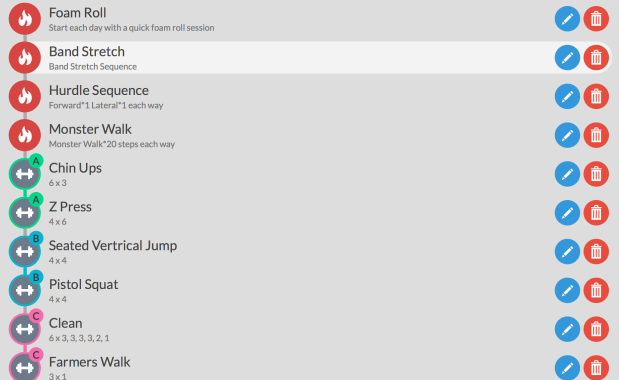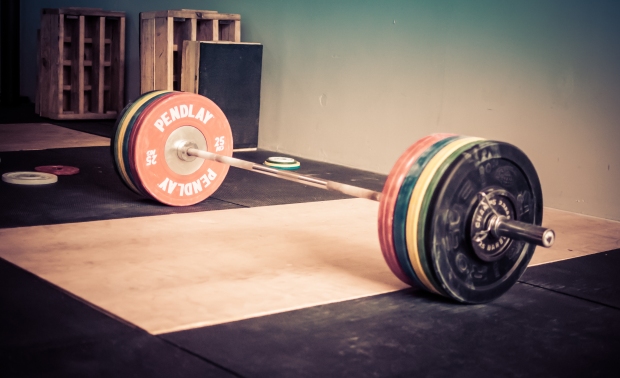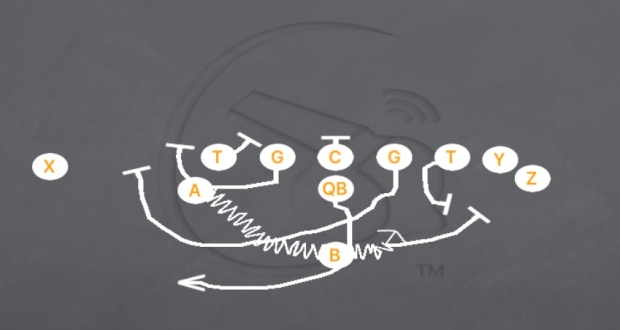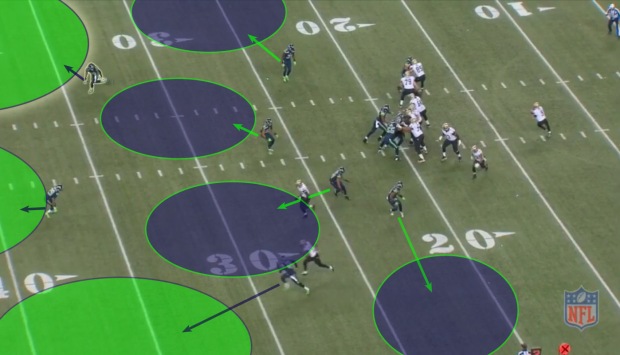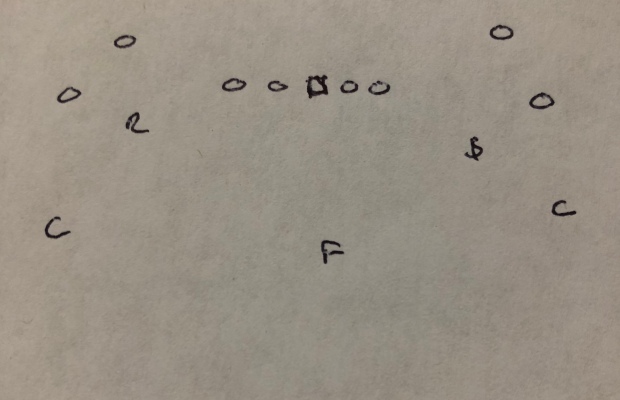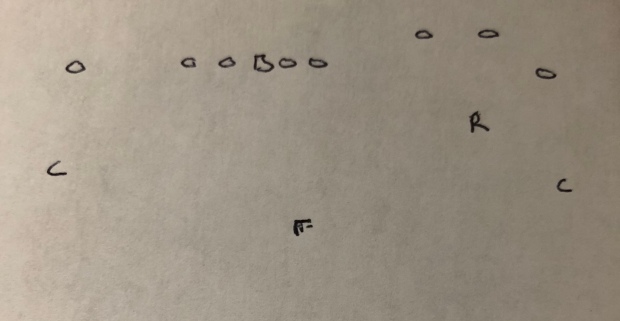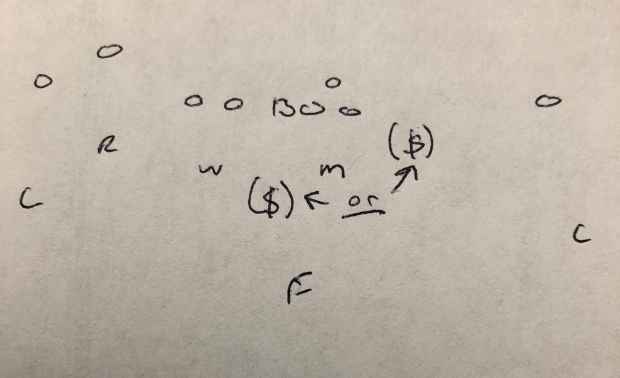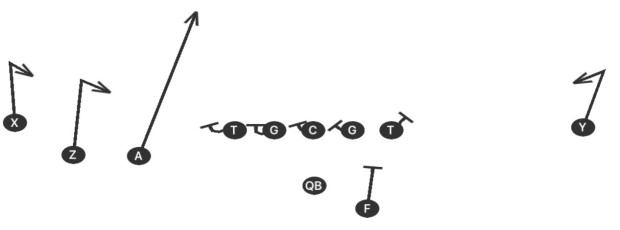INTRODUCTION
They say if you have your health, you can handle anything. For the most part that is a true statement. This guide is going to be about staying fit and being healthy for yourself, and for your family. I’m not here to tell you how to be on the cover of a muscle and fitness magazine, or win the next gold medal in the clean and jerk, but to provide a guide on how to establish and then maintain healthy level of strength, fitness and body weight.
Let’s face it, it can be a trying ordeal to accomplish this as a busy professional. Long hours, sporadic meals, of which many are of questionable decision making for the sake of convenience. On top of that, you have a family as well. How can you justify taking even more time from them? It is my belief that you owe it to your family to take care of yourself. Self care is self preservation, you can only take care of someone else when you are able to take care of yourself as well. You should be able to play in the back yard with the kids and not get winded. Or to have the general strength to take on work around the yard and house. This book will walk you through several easy to understand plans for diet, programming, and time management. Choose the plan that best fits your desires, goals and schedule and combined with intelligent food choices, you will avoid the dreaded “dad bod” look. (make sure read the diet section)
Dad Bod- the gradual accumulation of weight around the mid section as a result of high stress, low amounts of sleep and poor diet choices to make up for lack of time. Women are subjective to this condition as well, it will typically manifest around the hips, and under the arms for women.
For a lot of people, it is not to hard to remember when we were younger and in much better shape. Be that from general effects of youth, or maybe you played sports in high school or college. Think about how you looked when you first finished playing sports, or when you lived a more active lifestyle as a younger person. Think about the things you could do. While returning to the level you were at back then, or while you were playing a sport is not likely, we can get in pretty good shape! For some us, we may get into better shape than we have ever been in our lives! IT IS NEVER TOO LATE TO GET IN SHAPE!
An easy to implement and effective fitness program.
Being a Head Strength and Condition coach for many years, it would be safe to assume that I place a huge importance on strength development, as should all of us. I feel it makes the difference between good bodies and great bodies. Now, just because you are strong, does that mean you will have a great body? No, of course not. But, if you have somebody with a good looking body stand next to somebody with a great look body, I can tell that nine times out of ten, the one with the denser muscles will be much stronger.
I am not writing this guide to make you into the next Mr/Mrs Olympia or win the next CrossFit Games, I am however, writing this to give you a realistic, simple and very effective way to develop all around strength and fitness, without having to break out physics calculators and go percentage crazy. A simple system that is effective, easy to implement, easy to track, easy to hold yourself accountable and most important, able to do while still holding a job!
THE BARBELL IS KING
For the bulk of these programs, you will be focusing on use of the barbell. Dumbbells are great, bands serve purposes, machines are fancy looking. The meat of any program needs to be moving a loaded barbell. There is simply NO WAY AROUND THIS. If you want to effectively make changes in your health, fitness, strength, and physical appearance, you MUST major in barbell movements. The loaded barbell has NO equal in developing strength and fitness.
PROGRESSIVE OVERLOAD
What every program you decide to use, you must have progressive overload. The weight needs to get heavier overtime. The slower you do this the longer you can keep it going. Sub maximal lifting will increase maximal strength by progressively increasing weight and using proper set/rep schemes to utilize time under tension for placing proper stress on the body. The stress stimulates response in form of thicker tendons and muscles which in turn increases maximal strength. Without getting all technical about it, here is what that means. You will either add more weight to the bar, or you will add more reps to the sets in order to illicit change.
We Will Cover the Following Topics:
- The Get Strong Program
- 5×5 for a Tight Schedule
- Balanced Life and Body Program
- Metabolic Conditioning
- Diet and Meal Planning
PROGRAM 1: THE GET STRONG PROGRAM!
The purpose of this program is maximal strength development. It is the program that will take the most time in the gym. It should be done three days per week with at least one day of rest between each day. For example: Monday Lift, Tuesday Off, Wednesday Lift, Thursday Off, Friday Lift, Weekend Off. If you are a professional that travels a lot, reducing it to just two days a week will still work, but obviously will not give you the max benefits of the program.
SETS & REPS
For effective hypertrophy, you need between 20-30 total reps. For strength most studies agree with 1-5 reps per set. In this program the bulk is done with 5 sets of 5 at a set weight. This gives us 25 total reps, and 5 reps per set. I have experimented with 8 sets of 3 and 5 sets of 3 and 3 sets of 5. But the most bang for your buck and time spent in my experience use the tried and true 5×5 rep scheme, or the ramping rest pause method. (will be covered later!)
PROGRESSION
If you are new to lifting, you will start with just the bar! You are not allowed to use a loaded bar until you have mastered the 3 big movements (yes just 3). Once mastered you can increase weights with big plates only. So from the bar it will go 25’s, then 25’s are replaced with 35’s, then 35’s replaced with 45’s, then once you reach the weight of 135 pounds, you will increase in multiples of 10. So 145, 155, 165 etc.… The weights are only increased when all sets of 5 have been completed, so if your goes 5,5,5,3,2 you stay the same. If the lift goes 5,5,5,5,4 you stays the same. Only when the lift has attained 5×5, can you move up to the next load.
THE BIG 3
You will only track strength development in the Big 3. The Push Press, the Squat, and the Dead Lift. That is the meat of this program. I can already see the furrowed brows out there from those reading this and thinking, where the hell is arm curls and bench press… but hear me out before you pass judgment. (bench shows up later I promise lol)
Push Press-the push press is an awesome FULL body movement. You start in the rack position and dip the knees, high the hips slightly and extend locking the elbows at the top. DO NOT drop under the bar. Drive the bar up push the head through the arms to lock it out before returning the bar. I prefer Push Press to bench because it is an explosive movement, and you do it standing up, which requires more nervous system involvement.
Front Squat– we choose front squat because almost everybody can front squat correctly. It is a more natural and athletic movement than the back squat. It is very natural for the lifter to be able to sit below parallel (yes squat below parallel). The lifter remains upright and in an athletic position. You will still use back squats which I’ll cover later but they are not the in the Big 3 for this particular program. When self-coaching the front squat the simple cue of “elbows up” seams to take care of 90% of form issues. When front squatting always use the front rack position, NOT the arms crossed position! This rotates the AC joint forward and the bar will roll forward instead of sitting back on the front deltoid/pectoral shelf created by the rack position.
GOOD BAD
If you have an issue with bad wrist mobility, this is the accommodation that you should use. This allows the lifter to maintain the “elbows up” position.
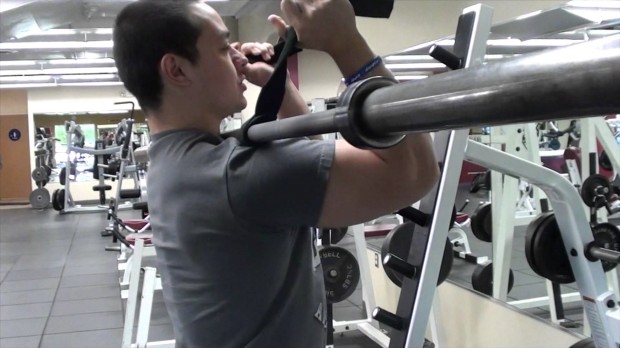
Dead Lift-the dead lift is the king of maximum strength development. The entire posterior chain is activated during the dead lift as well as the trapezius, biceps and quadriceps. Strengthening the hinge movement is crucial to functional strength, you use the hinge when stand up, lift things off the floor, run, jump, walk, play with the kids… basically for any daily movement. When dead lifting cue yourself with “eyes up” before you grab the bar. (don’t look at the ceiling, but don’t look at your toes/bar either) You are not allowed to look at the bar when grabbing it or lifting the weight. This forces a low hip high chest position that we want. You will use a double overhand grip on the dead lift to limit weight and promote balance. Once you can dead lift 300 pounds for a set of 5…then you can start using a cross grip. You will focus on perfect technique and bar speed over weight, bar speed trumps maximal weight here, save that for when you choose to do max outs and test your strength.
Back Squat-while the dead lift is king of strength. The back squat is king of mass accumulation. You will use back squats for high reps once a week at the end of the work out and I’ll show where and how it fits accordingly.
THE PROGRAM
Pre Workout-do whatever normal warm up you like. I prefer short and sweet, get moving > static stretches. Such as high knees, A-Skips, but to each his own. After the general warm up I insist on a set of 5 of broad jumps or vertical jumps to do a pre lift explosive primer. Get the fast twitch muscles activated. Once in the weight room, do 2 sets of 5-10 pull ups and dips. Not looking to wear yourself out. Just get the blood moving and your body prepared for the strain of lifting. If you’re a big body, sub with rows/pull downs and push ups but I encourage you to try daily to do pull ups and dips, eventually you will be able to complete some.
Then you start the main lifts:
Push Press 5×5
Front Squat 5×5
Dead Lift 5×5
Remember, only increase load once all reps are attained.
The days you will lift are Monday, Wednesday and Friday, or Saturday, Monday, Wednesday. After the big 3 on Day one, go outside for loaded carries, med ball throws and some core work. Mix it up, have fun with it, no need to go crazy, especially if on a time crunch. After the big 3 on Day Two, do open weights for 15-20 minutes. Do whatever lift you want, bench, curls, calves… it is entirely up to you. After the big three on Day Three, you have widow makers! You get in the rack and do high rep back squats. you are going for 30 total reps. Start with just the bar just like the other lifts and progress the same way! Once you can get 30 reps in two sets or less, you can increase the load as prescribed. These will really gas you out, and you will feel lots of rubbery legs the first few weeks. This will also drive your appetite through the roof, which is good for muscle gain… but do not over do it.
SUMMARY
This entire lift should take no more than 60-70 minutes to complete. If it’s longer than that your wasting time somewhere. You want be on the move, in and out! It’s simple, it has only 3 lift days but 75 total weekly reps. Plenty of time left to focus on the rest of your life. When you get to a point where you are not advancing any more on five sets of five, switch to three sets of five so you can keep adding weight. Also, feel free to sub back squats for front squats if you must.
PROGRAM 2: 5×5 FOR A TIGHT SCHEDULE
You have two types of programs that are most likely the best bang for your buck! 5×5 will never be a bad choice for both strength and hypertrophy. Multiple sets give you volume needed for hypertrophy and 5 reps per set allow for heavy weight to be used. It’s arguably, the best of both worlds. You get adequate load used, as well as adequate time under tension (how long the weight is being lifted for.) What are the draw backs? For a busy person with a job, especially if it’s a job that requires travel, or long hours like coaching, or outside sales, 5×5 can simply take too much time. Throw having kids into the mix and it can be downright impossible to spend that much time in the gym, even if it is only two or three days per week. So, how do we mitigate the time constraints of being an adult, and still be responsible for our own health and well being? That is the question that I am going to answer for you in this program!
This program will divide your work outs into two different, three day rotations with one day off between rotations. Example schedule will look like this: Monday, Tuesday, Wednesday, off. Friday, Saturday, Sunday, off. Tuesday, Wednesday, Thursday, off, and so forth.
Each workday should take no more than 30 minutes. If it takes any longer than that, as I have said before, your doing it wrong. Time between sets should be no more than 2 minutes; but try for 90 seconds or less if you can. Each day is going to focus on just ONE main lift, and ONE supplemental lift that will be incorporated into your conditioning circuit after the main lift is done.
THE BIG LIFTS AND STARTING WEIGHTS
You will have 6 BIG LIFTS to focus on for this work out program.
Rotation One Lifts are: Push Press, Front Squat and Dead Lift. The coinciding supplemental lifts are Pull ups, Sit Ups and Barbell Curls.
Rotation Two lifts are: Bench Press or Weighted Dip, Back Squat and Power Cleans. The supplemental lifts for rotation two are: Barbell Rows, a Plank Variant and Chin Ups.
For each of the Big Lifts you will choose one of the following starting weights: 45, 95, 115, 135, 185, 225, 275, 315, 365, 385, 405. Always choose lighter than you think you will need to begin this program. So, if you are pretty certain you could get 5 sets of 5 at 225 pounds, you should start at 185 pounds to give you room for steady progression
SETS AND REPS
As the title of the program fore tells, you will be doing 5 sets of 5 reps. You will keep the same weight across all sets. On your last set you will try for as many reps as possible while maintaining good form. Some days you will feel great and get 6-10 reps, other days you will struggle to get 5 and that’s OK. If you get ALL 5 reps on ALL 5 sets then you will increase the weight by 10 pounds. If you miss just one single rep, you will keep the same weight and try again on the next rotation.
SUPPLEMENTAL LIFTS AND CONDITIONING
To save time you will combine your supplemental lifts with conditioning into a circuit consisting of 3 to 10 rounds or in an “as many rounds as possible” in 10 to 15 minute time windows. These circuits are NOT cardio, they are metabolic conditioning. Your supplemental lifts should aim for 30-50 total reps by the end of the circuit. There are several ways to go about doing this. One, you can pick one of the MetCons I provide in the section called Metabolic Condtioning. Or another easy way is to look at something like CrossFit’s website for the WOD and just add your supplemental lift to the WOD or replace an exercise with yours. I like to get creative. Here is an example for Push Press day:
10 rounds of: 5 pull ups, 10 kettlebell swings, 10 kettlebell thrusters. Personally I like to make my conditioning circuit a full body circuit. So, even though my main lift will be either upper, leg, or hip focused, the MetCon can hit the entire body. This is good for strength, fat burn and overall muscular development.
SUMMARY
This workout takes one of the most effective workout programs ever developed and makes it applicable to the everyday working professional. Everybody can take 30 minutes or less for a workout. If you have to miss a day because of responsibilities, its no big deal. The scheduling of the program allows you to simply pick up where ever you left off. Give this program a try for three months, if you can do that consistently paired with good diet and good sleeping habits you will get stronger and in better condition.
PROGRAM 3: THE BALANCED LIFE AND BODY PROGRAM
We are adults, we work all day then sometimes go work or travel for 2 to 3 more hours before coming home. During the weekends we often have second jobs or if we are home, we usually are still doing some work at some point. This is not going to make you set any records or grace the cover of muscle and fitness…well if it does make sure you credit me! All joking aside, This program is designed to get you stronger and make you look like you could still play a sport if you had too, and hopefully, make you feel confident in swim attire. The whole thing will take between 15 and 30 minutes, and it is 5 to 6 days a week depending on the rotation and how you are feeling recovery wise.
This is my personally preferred workout program. It uses an overload method called the “Ramping Rest Pause”. Working out more days for shorter amounts of time is the best way to go. It develops habits, and you are in and out of the weight room, vs the other method of three to four days a week and in the weight room for an hour, sometimes more. You will have a warm up, a strength lift, a supplemental lift, a MetCon and then you are done. MetCon stands for metabolic conditioning. It was established by the Russian weightlifting team in the 1940s. Today, hipsters like to call it crossfit (Don’t worry, we won’t be doing any flying monkey snatches). It is short, it is intense, it gets the heart rate up, which is what we want. (see Metcon Section)
Warming up is easy, you can do old school calisthenics, a quick jog or my favorite, jump rope. I highly recommend jumping rope, it is a great whole body warm up, primes the central nervous system and only needs to be done for 1 to 3 minutes. It is also a good test to determine how the day is going to go. If you blast through the jump rope you can probably really get after the weights. Stumble and smack your shins and your back a lot…you probably should take it easier as your nervous system may need a break.
After you warm up you will do as many pull ups as you can, take ten deep breaths, and do as many as you can again. Once done with this, you will move onto the main lift.
The program goes 3 days on, and 1 day rest/off
Day One
Squat Move (back squat, front squat, split squat) you pick. I would pick one lift to focus on and then rotate them every 3-6 months if you are getting bored.
Squat Move (Lunges, Front Squat, anything that targets the legs or gluteals)
MetCon
Day Two
Hinge Move (dead lift, Cleans)
Hinge Move (Clean variant, Snatch Variant, kettlebell swings, jumping, RDL)
MetCon
Day Three
Push Move (Push press, bench, dips, strict overhead press)
Push Move (close grip bench, push ups, dips, tricep extensions)
MetCon
Rest day, then repeat Day one
You will only track the last set of each main lift. The first one to four sets will be ramping sets of FIVE reps that progressively get heavier till you get to your work set. These sets warm you up for the last set. Then for that weight you will try to get as MANY as POSSIBLE. Once you can get between eight and ten, you know that the next time that you do that lift, you can move up five to ten pounds. After the work set no matter how many you get, take ten to twenty deep breaths and do it again, you may only get one or two reps but that is OK. The idea is that you did it again while the body was still taxed. This is called a “Rest Pause”. You get back under the bar while you are still slightly fatigued and rep out a few more! This is great way to provide stress on the muscular system and it elicits growth and hormonal response. An example ramp might look like this,
Back squat-45×5, 135×5, 225×5 and 275×7, 20 breaths then 3 more reps.
MetCons are simple, get moving fast with inefficient movements to increase the heart rate. Combining two to three movements seams to work best. One of my favorites is combining jump rope with push ups. Jump rope for 30 seconds as fast as possible then do 20 push ups and go back and forth for 10-15 minutes. No MetCon should take longer than TWENTY minutes. Always cut it off at 20 minutes, ten to fifteen minutes is usually what I go for. Another combo is burpees and sit ups. or jogging and jumping jacks. The good thing about a MetCon is, it can be different every day. Several MetCon examples are given in the Section titled “Metabolic Conditioning”. Pick from one of these each day and you will never go wrong. Simply pick one of the MetCons that has a supplemental lift from your list and go! (It is OK if you double up movements day to day)
If all that is too much to think about, and you just want to be told what to do. Here is what I do personally and have experienced lasting success!
Day One: jump rope three minutes, pull up rest pause, back squat rest pause, metcon with a leg movement in it, abs or curls if I have time left over.
Day Two: jump rope three minutes, pull up rest pause, dead lift rest pause, metcon with a hinge movement in it, abs or curls if I have time left over.
Day Three: jump rope three minutes, pull up rest pause, over head press rest pause, metcon with a press movement in it, abs or curls if I have time left over.
TIME MANAGEMENT
This whole work out should take no more than 30 minutes, 20 should be an attainable average. But you are working out five to six days per week to make up for the short time. You can fit twenty minutes a day anywhere. Wake up early to get to a gym. If you are like me and have stuff in your garage, do it there in early morning, or after the kids go to bed. Maybe you’re a teacher or coach at a school, use the school weight room, get in early. Do it on your plan period, its only 30 minutes of working out.
Do it on your lunch break. Do it right after work before you get home, stop by that gym on the way, but once your home let that be family time. Either start your day with the workout while the family is asleep, or do it before you get home at some point. You should let home time, be home time. You can also use family time as a way to get extra general movement in. Play with the kids outside, or go for a family walk, walk the dog. We live right by a wild life preserve called Turkey Creek, I love to take my son there and walk the trails. Its bonding time and some extra movement to help maintain a healthy life style.
SUMMARY
This should be more than enough to get you started and maintained for a long time. Finding time to keep ourselves healthy is a priority if we want to be there for our family and set a good example for our children to be healthy as well. If you ever get to a point where you are stalling out on a lift and not seeing progress, simply change the main lift and keep going from there. This program is probably the all around best one to use for those of us that have limited time to spend working out.
METABOLIC CONDITIONING
Metabolic Conditioning or MetCon for short, has been recently popularized by the “CrossFit Crowd”. In reality, it was first used during Soviet era Russia by its Olympic Athletes as a way to condition them, build strength and develop work capacity in the most time efficient manner. What they discovered was what would become one of the, if not the most effective conditioning tool in the exercise world.
So, what is our goal when using Metabolic Conditioning? We can get technical and talk metabolic pathways… but that kind of defeats the purpose of this manual. So, in laymen terms, the goal of metabolic conditioning for these programs is to accomplish a few things. One, to increase your ability to complete work in a given time period, something called “work capacity”. Two, to elicit fat burn by rapidly depleting muscle glycogen and creatine levels while simultaneously increasing heart rate. This causes spikes in growth hormone and “EPOC” (excessive post-exercise oxygen consumption). Finally, to build muscle. The reps done during the MetCon will add overall volume to your resistance training by adding reps. The “Complexes” are especially effective at this. All this should be done in the ideal window of ten to fifteen minutes. For this manual we will focus on three types of MetCons. TABATA, AMRAP and Complexes.
TABATA
Tabata is a form of high intensity exercise invented by Dr. Izumi Tabata. It consists of four minutes of work, that’s right, just four minutes. But don’t let that fool you! It can be extremely intense depending on the exercise you choose to use with it. Here is how it works, you will exercise for twenty seconds as hard as you can, and then rest for ten seconds. You will repeat this eight times for your four minute total. When doing tabata as your MetCon you should do two, four minute rounds with different exercises and one to two minutes of rest between rounds. This gives you eight minutes of work and up to two minutes of rest for a MetCon that lasts ten minutes. Which is in our ideal, ten to fifteen minute window. When choosing exercises for tabata, as a general rule, movements that incorporate a lot of body movement are best. If you are going to use weights for tabata, always choose a weight lighter than you think you can do for the sake of staying in good technique and remaining safe. Here is a list of exercises that are great for tabata:
Burpees
Burpee Pull Ups (do a burpee, then jump up and do a pull up)
Jumps of all kinds
Kettlebell/Dumbbell Swings
Kettlebell/Dumbbell High Pulls
Dumbbell Clean and Presses
Jump Rope
Double Unders (jump rope where the rope pass two times per jump)
Lunges
Running
You can choose other exercises to use if you wish, but in general, exercises that involve a lot of body movement will give you the most bang for your time!
AMRAP
AMRAP is an acronym for “As Many Rounds As Possible” or “As Many Reps As Possible” in a given time period. Remember, we want that ten to fifteen minute time window. You will choose between one to three exercises for the AMRRAP, a time window, and then complete as many rounds/reps as you possibly can within that window. Do not aim to pace yourself for these. It is better to stop and catch your breath, than it is go at a slower pace. It is that rapid increase in heart rate that we are going for. As time goes on, you will find that you can go harder for longer (that’s what she said). Here are some great examples of AMRAPs that you can use for your MetCons:
Burpees
Double Unders
10 Kettlebell High Pulls, 10 Kettlebell Swings, 10 Sit Ups
50 Rope Jumps, 10 Push Ups
2 Pull Ups, 5 Push Ups, 10 Bodyweight Squats
10 Lunges (each leg), 20 Mountain Climber
2 Clean and Press, 10 Burpees
50 meter Farmer Walk, 20 Push Ups, 20 Crunches
50 meter Sprint, 25 Push Ups
8 Bench Press, 8 Burpees
5 Box Jumps, 5 Lunges, 5 Push Press
COMPLEXES
As far as MetCons go, it is hard to beat the Barbell Complex. They can be downright brutal in difficulty, but they are extremely effective. If ever in doubt about what to do for a MetCon, choose a complex. They have the unique ability to build muscle and burn fat. To produce strength gains, and improve work capacity. Complexes are a gift from the fitness gods to athletes and average Joes alike.
When doing complexes you have one major rule. DO NOT let go of the bar until the round is complete. For ALL complexes, you will choose from one of the following weights to put on the bar. 45 (the bar alone), 75 pounds, 95 pounds, 115 pounds, 135 pounds, 155 pounds, 185 pounds, or 225 pounds. To speak frankly, if you can complete these with 225 pounds or more…. Then you’re a frickin animal! Remember, once you start the round, you will NOT let go of the bar until that round is complete. Also remember to work as hard as possible for ten to fifteen minutes, NO MORE. Here are the Barbell Complexes that you can choose from:
Chicken Little- 3 Power Cleans, 3 Jerks, done for 3 rotations per round.
Chicken Kickers- 3 Clean and Press, 5 Front Squat, 8 RDLs for 5 rounds.
Buck Bucks- 2 Power Cleans, 2 Front Squats, done for 5 rotations per round.
Buck Bucks Lite- 2 Power Cleans, 2 Front Squats, done for 3 rotations per round.
Clean Up- 3 Cleans from floor, 2 Hang Cleans from knee, 1 Hang Clean from thigh
Man Maker-8 RDL, 8 Rows, 8 Push Press, 8 Back Squats, done for 3 to 5 rounds.
To and Fro- 5 Deadlifts, 10 Push ups Holding bar, done for 5 rotations per round.
Redskins- 5 Cleans, 5 Push Press, 5 Back Squats, done for 8 rounds.
Snatch To It- 5 Snatch Jerks (behind head), 5 Snatches, 5 Snatch Pulls, done for 8 rounds.
FHF- Front Squat to Overhead Press, Pull Ups, Sit ups. Done for 4 rounds of the following reps: 20, 15, 10, 5.
Pull n Swing- 20, 19, 18…. All the way to 1 of: Kettlebell High Pulls and Swings.
Remember when doing these complexes to go has hard as you can and rest as needed. If you hit that fifteen minute time limit, then stop where you are, even if you are not done. You will have good and bad days, all that matters is improvement over time!
DIET AND MEAL PLANNING
I am definitely no expert in nutrition, but I can tell you this. We are adults, and we know how to eat healthy and make adult decisions. I get it, and I’m guilty too from time to time. Those convince stops for food save time. We all know that stopping for fast food after work, and/or kids practices/games is not the best choice, and it usually becomes a habit. A habit that can lead to pounds stacking up each year. Add a few years together and you start to go buy bigger pants. Its not just after work either. Starting your day with cereal that comes out of a box with a cartoon character on it should not be on your things to do. All the exercise plans in the world cannot overcome shitty eating. That may sound harsh, but it’s the truth, and that being said, let’s take a look at some food choices.
Here is a list of foods to avoid:
SODA (by all means, even diet…stay away!)
Wheat (any carbohydrate that comes from a box or bag. Ex: sugar, cereal, bread, bagels…you get it)
Corn (its bad, no it’s not a vegetable)
The problem with corn and wheat is that its literally in everything! So as a general rule, buy food from the outside perimeter of the grocery store.
Dairy (ok in small amounts)
Pork (yes its awesomely delicious, save it for special occasions)
Beans and rice (highly estrogenic, estrogen = boobs)
Here is a list of foods to eat:
WATER (the best anabolic hands down)
Vegetables (all kinds, all colors. Eat lots. Mom was right all along)
Fruit (the more fibrous the better)
Things that used to have a face (chicken, beef, fish and so on)
Eggs
Potatoes (white, sweet, red… all OK. Just keep them on workout days)
Nuts
MEAL PLANNING
Planning your meals makes eating healthier very easy. Its really not that hard to do. Tupperware on amazon is like five bucks for five containers. Cook three to five lunches for work and stick them in the fridge. Eat eggs and other meat along with fruit and or vegetables in the morning. For dinner have one of the pre-made meals or cook something that is on the good list I provided.
What to cook with:
When cooking your meals, what you cook with, is important as well. As a general rule, use and avoid the following items.
Avoid
- Vegetable oil
- Canola oil
- Heavy Dressings
Use
- Coconut Oil
- Extra Virgin Olive Oil
- Balsamic Vinaigrettes
- Liquid Aminos
- Real Butter (yes its OK, just don’t go crazy)
What To Cook
In general for every meal you at least want 1 protein source and vegetables. Try to save carbs for after workouts only if you’re trying to lose weight. If not, then be light to moderate with carbs and heavier after working out. With vegetables, in most cases raw is better, so you’ll only have to worry about cooking proteins and carbs. There are lots of sources out there that will tell you eat so much protein per this and that, it can drive you nuts trying to count all that nonsense. Just eat a lot of protein, and eat lots of vegetables… nobody ever went wrong there. If you feel like you’re staying too sore for too long after working out, then eat more protein, drink more water and sleep more. 99% of the time, that will fix it.
How to Cook It All
I would only recommend cooking 3 days in advance. So on Sunday cook for Monday through Wednesday. Then Wednesday cook for Thursday through Saturday. This way you won’t get fed up (no pun intended) with the same meals over and over, and it reduces the chance of food getting wasted by going bad. For how to cook the food I recommend ways that allow you to cook the most amount of food with minimal amount of time and/or thought. Here are some easy suggestions
- Crock Pots
- A very easy and delicious way to cook a lot of food. The bigger the crock pot the better. Put in your protein source, your vegetables, and your carb source (if desired…I like potatoes lol) and then fill 2/3 the way with water. If your doing a pork roast a recipe my wife swears by is as follows:
- 3 lb to 4lb pork butt
- 1/2 cup soy sauce,
- 1 tbsp minced garlic
- 2 tsp honey
- 1/3 cup balsamic vinaigrette
- 1 bag of baby carrots
- Cup of chopped celery
- 4-6 medium red potatoes cut in quarters
- Set it on low Sunday morning and then Sunday night evenly distribute it into Tupperware. (if you can manage not to eat it right then) allow to cook on low for 8-10 hours or on high for 5-7
- Grill
- Fire up the grill, if your grilling on weekends anyways, what better time to throw some extra food on for your weekly meals? Grilling is very versatile and can cook every food item you want. When you are done, again evenly distribute the food into your weekly meal containers The foods I recommend cooking on the grill are turkey burgers, chicken breast, or a beef. You can easily do vegetables as well. The ones I have found I enjoy on the grill the most are zucchini, summer squash, bell peppers, and even asparagus just watch closely as it does tend to wilt if the temperature is too high so if you have a double rack grill use the top rack for your veggies.
- Oven
- A couple of oven pans and you can get a lot of food cooked very quickly. Choose your protein source, vegetables and carbs if desired and your good to go. I like to cook chicken for salads this way. Season the chicken up before I recommend using the Flavorgod seasonings they are salt and msg free, they taste good and lots of variety in flavors, putting them in the oven. You want to cook chicken at 325-350 as to not dry it out. While they are cooking, get the salads ready in the Tupperware and all you have to do is add the chicken when its done.
- A good trick to making a salad not suck is adding texture to it and by that I mean bell peppers, raw and diced, avocado, shredded cheese, are just some things to name a few that makes a subtle change with a big taste change.
- Another thing I like to do is cook eggs in the oven. Egg pop-ables as they are called are an easy low effort, nutritious, and convenient breakfast food that can be portable for the coach on the go. Take a muffin tin (make sure its not your wife, or girlfriends good one) and use coconut oil or extra virgin oil both can be bought in a spray can form and still be good for you-make sure to spray the sides well, to grease the individual units and crack one egg in each. Add other things if you like for taste, some combos I have enjoyed are cut up sausage and shredded cheddar, you can even get fancy and I say that loosely, and put bacon around the muffin cup lining then crack your egg and whisk it, add some salt and pepper to taste. Now you can cook 2 dozen eggs in less than 15 minutes. Set your oven to 375 and cook for 20-25 minutes depending on how done you like your eggs. Makes a good healthy snack or quick breakfast you can grab. Make sure to bag them in some sandwich bags grab 2-3 eggs and a piece of fruit and you are good to go
- As for in between food to make sure your staying satisfied between meals, practices, and meetings have some food on hand like, jerky or almonds, fruit etc…. and as always drink plenty of water.
Most of you will lose weight just by cleaning up the diet, but if you want aggressive weight loss, it can be attained. Here is my disclaimer. From my time cutting weight as a wrestler I can tell you this, the faster the weight is lost…the higher the amount of suck it will be. It also has a greater chance of rebounding back after. Well, here it is, get some protein powder and you only get one solid meal a day. One shake in the morning upon waking up, one mid-morning, one for late lunch and one after work. Protein shake is mixed with water. Your single solid meal will be meat and vegetables, no carbs. Again, this will SUCK! It will however get the weight off you. I would not stay on this for more than 20-25 days at a time. Take a few months of normal healthy eating before repeating. For most of us, just following basic healthy adult eating will be fine. As a general rule, follow the 80/20 rule. that it, 80 percent of your diet should come from the good list, and the other 20 percent is so you don’t have to be food prude all the time.
INTERMITENT FASTING
If you want an eating plan that is both healthy, effective, flexible and sustainable, then intermittent fasting is probably something you should look into. Its not for everybody, but I find as a professional, it is by far the easiest and most flexible style of eating out there. Here is out it works:
You will choose an eight hour eating window. If it is not in this window, you will only have black coffee, or clear water. The window can start no earlier than 11:00am for a female and 1:00pm for a male. For males, most guys find it the most beneficial if they don’t start their eating window till between 2:00pm to 4:00pm. Remember, nothing but black coffee and clear water outside of the eating window.
So why does this work? The sixteen hour fast does several things. It allows hormone profiles to stabilize, keeps insulin production low, keeps you focused and mentally sharp because you don’t have full belly making you sleepy. Growth hormone and testosterone production elevates when used in conjunction with lifting weights.
When you break your fast, the first meal is the most important. Not so much as what you eat… but how much you eat. You want this first meal to be smaller, just enough to raise insulin a small amount so you don’t have a huge spike. After an hour or two you can have a bigger meal, or dinner at home. Usually you can have an evening snack as well and be fine. Due to the fast and the limited time eating, you can be much more liberal in your food choices than if you spent the whole day eating. (this is not an excuse to pig out on candy and ice cream lol) Again, I am not a nutritionist! This is taken from my own research and experimentation. It has been effective for me, and for many others. It is definitely worth researching and exploring to see if it is right for you!
SUMMARY
Nothing here is cutting edge or super thought provoking. Again it goes to making adult decisions and deciding to be healthy for ourselves and our families. It doesn’t have to be hard, or bland. You can still eat good tasting food and be healthy. And as always if we practice what we preach to our family and lead by example we can help shape a more health conscious community that will lead a healthy lifestyle.
CLOSING STATEMENTS
I truly hope that this helps you in your quest to a healthy lifestyle. There is a lot of misinformation out there in fitness world and my goal with this is to provide something that is practical, and something that real people can effectively implement into their daily lives. I could make outlandish claims that this guide is all you need and will make you into a ripped god or goddess… but I will leave you with this as a set of general truths in the world of exercise and health:
- The two things you must have to get stronger are: consistency and progressive overload.
- The two things you need to get “fit” are: appropriate and consistent exercise, and proper nutrition.
